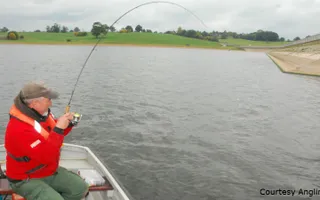Don't rely on luck
The phrase ‘it's better to be lucky than good' has been uttered numerous times over the decades. After the fishing year he's had, winning the Wolverhampton canal festival and captaining the Crewe Match Group team to victory in Division 2 National, the saying might apply to Let's Fish! coach Simon Mottram. Simon's biggest slice of luck came not at the draw-bag; rather it was dicing with death and still being here to tell his tale.
If you fall in, stand up!
Aged just ten, Simon fished his first big match back in 1990, the NFA Junior National Championships on the Grand Union Canal. Simon recalls what happened at the start of the match.
"I drew peg B45 at Wolverton. The whistle went at 11.00am and almost immediately disaster struck. I somehow lost my balance and I and my seat box ended up in the cut. I knew canals were shallow and so I stood up and hauled myself and box back onto dry land. It was a roasting hot day, well over 30°C. It must have been 15 minutes into the match before I could start fishing properly."
Luckily, nothing untoward happened to Simon that day but imagine for a moment if the water had been six or eight feet deep with a fast current. It could have ended ivery differently.
Simon dices with death
By the mid 1990s, Simon, one of the top junior anglers in the UK, and his pal Chris Harvey were becoming proficient at bloodworm and joker fishing. When not fishing, they spent time scouring the Shropshire countryside for ponds that could be possible sources of the bait. It's known as ‘bloodworm scraping'.
One cold winter's day, they found a plentiful supply in a farmer's pond near Bettisfield. When the farmer discovered their activities, he was extremely irate and asked them (not very) politely to depart. But, boys being boys, Simon and Chris promptly ignored the instruction and sneaked back to the pond.
Disaster struck
Inevitably, water went over Simon's chest waders and he quickly found himself firmly stuck, unable to move. Despite Chris' efforts to pull him out, an hour had flown by, Simon was still unable to move and was sinking inexorably. There were no mobile phones back then. The water was up to the top of his neck and darkness was rapidly approaching. Simon began to shiver badly.
There was nothing for it now but for Chris to run nearly a mile to fetch the farmer. Even he was unable to pull Simon out of the mud. The Fire Service was then called and it was they who managed to save Simon's life. The ambulance duly arrived and Simon was rushed to hospital with hypothermia.
Fortunately, this story has a happy ending. It even made the national press, including the News of the World.
Safety tips for anglers to consider
- Check the weather forecast and weather conditions before you go fishing
- Make sure you let someone know where you are going to fish
- Make sure you know exactly where you are – consider something like an OS locate app for a smart phone or a map
- Give friends or partners an idea of when you are likely to return
- Take a fully charged mobile phone and check signal strength, know how to use it and who to call in an emergency
- Double check your fishing spot. Is it safe? For example, riverbanks can erode and just because it was safe one day doesn't mean that it still is
- Always dress appropriately, sturdy footwear, sun hat in hot weather, warm layers in cold
- Coastal and sea fishing is particularly high risk. Make sure you know your spot is safe and that you won't get cut off by the tide
- Expert evidence suggests that many lives would have been saved if the casualty had been wearing a lifejacket. Wear a lifejacket when conditions warrant it. Life jackets should always be worn when fishing from a boat
Canal fisheries: some of the nation's safest fishing venues
It makes them great places to host our Let's Fish! events or for young people to subsequently fish in safety. There is virtually always a flat level area close to the water's edge that can safely accommodate the angler's box.
The majority of our narrow canals have shallow water near the edge with perhaps 60cm depth in the margins and maybe 1.5 metres in the central channel. Some of the ship canals such as the Gloucester & Sharpness Canal and Aire & Calder Navigation are much deeper and you need to take extra care on these waterways.
Spreading the safety message and getting more advice
Without Chris being there that day, Simon Mottram would definitely not have been with us now to tell his story. To help spread the water safety message, please do share this blog. Who knows, reading this may just help save the life of a fellow angler.
For more information, see our water safety advice, please contact your local fire service.





